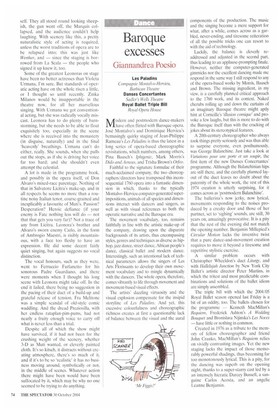Baroque excesses
Giannandrea Poesio
Les Paladins Compagnie Montalvo-Hetvieu, Barbican Theatre Danses Concertantes Sadler's Wells Theatre Royal Ballet Triple Bill Royal Opera House
Modern and postmodern dance-makers have often flirted with Baroque opera. Jose Montalvo's and Dominique Hervieu's bemusingly quirky staging of Jean-Philippe Rameau's Les Paladins is thus the latest in a long series of opera-based choreographic revisitations, which numbers, among others, Pina Bausch's lphigenie, Mark Morris's ado and Aenea.s, and Trisha Brown's afeo.
Faithful to the signature formulae of their much-acclaimed company, the two choreographers/directors have transposed this inconsequential 1760 opera into a fantastic dimension in which, thanks to the typically Montalvo–Hervieu computer-generated superimpositions, animals of all species and dimensions interact with dancers and singers, as well as with visual references to both the operatic narrative and the Baroque era.
The movement vocabulary, too, remains faithfully in line with the artistic make-up of the company, drawing upon the disparate backgrounds of its artists, thus encompassing styles, genres and techniques as diverse as hiphop, .077 dance, street dance, African people's dance, classical ballet and modern dance. Interestingly, such an intentional lack of technical parameters allows the singers of Les Arts Florissants to develop their own movement vocabulary and to mingle dynamically with the dancers. "'be whole opera, therefore, comes vibrantly to life through movement and movement-based visual effects.
The artists' da77Iing virtuosity and the visual explosion compensate for the insipid storyline of Les Paladins. And yet, this excessive colourfulness and choreographic richness creates at first a questionable lack of balance between the visual and the aural
components of the production. The music and the singing become a mere support for what, after a while, comes across as a garbled, never-ending, and tiresome reiteration of all the possible tricks one can resort to with the aid of technology.
Luckily, the balance is cleverly readdressed and adjusted in the second part, thus leading to an applause-prompting finale. However, neither the computer-generated gimmicks nor the excellent dancing made me respond in the same way I still respond to any of the opera-based works by Morris, Bausch and Brown. The missing ingredient, in my view, is a carefully planned critical approach to the 1760 work, and its context. Naked cherubs rolling up and down the curtains of an imaginary Baroque theatre might aptly hint at Corneille's 'illusion comique' and provoke a few laughs, but this is more to do with the Baroque itself than with the cracking of jokes about its stereotypical features.
A 20th-century choreographer who always took things pretty seriously and was thus able to surprise everyone, even posthumously, was George Balanchine. Just take a look at Variations pour une pone et un soupir, the first item of the new Danses Concertantes' programme. Although the Balanchinian hips are still there, and the carefully planned layout of the duet leaves no doubt about the paternity of the whole work, the rest of this 1974 creation is utterly surprising, for it comes across as 'postmodern BalanchinC.
The ballerina's now jerky, now lyrical, movements responding to the noises produced by a creaky door and those of her partner, set to 'sighing' sounds, are still, 30 years on, amazingly provocative. It is a pity that the rest of the evening did not match the opening number. Benjamin Millepied's Circular Motion lacks the inventive twist that a pure dance-and-movement creation requires to move it beyond a tiresome and repetitive stylistic exercise.
A similar problem occurs with Christopher Wheeldon's duet Liiwyy, and with Hallelujah Junction by New York City Ballet's artistic director Peter Martins, in which the tritest and most predictable combinations and solutions of the ballet idiom are simply assembled.
The triple bill with which the 2004/05 Royal Ballet season opened last Friday is a bit of an oddity, too. The ballets chosen for the programme — Kenneth MacMillan's Requiem, Frederick Ashton's A Wedding Bouquet and Bronislava Nijinska's Les Noces — have little or nothing in common.
Created in 1976 as a tribute to the memory of fellow choreographer and friend John Cranko, MacMillan's Requiem relies on vividly contrasting images. Yet the new staging lacks the impact of those memorably powerful shadings, thus becoming far too monotonously lyrical. This is a pity, for the dancing was superb on the opening night, thanks to a super-starry cast led by a an intensely hieratic Darcey Bussell, a sanguine Carlos Acosta, and an angelic Leanne Benjamin. Stylistic mushiness also detracted considerably from Les Noces, one of the most internationally acclaimed titles of the Royal Ballet's repertoire. Although the dancing was impeccable, the movement vocabulary lacked disappointingly that unique angularity and harshness for which this 1923 creation is famous. And 'disappointing' is also the term that best summarises my reaction to the long-awaited restaging of Ashton's A Wedding Bouquet. What was once a refined, humorous ballet seems to have become an unbearably exaggerated caricature, the motto of which is 'camp it up'. Only Alina Cojocaru as the Bride and Tamara Rojo as Julia managed to remain untouched by the utter vulgarity that informed the ongoing action. I hope that future performances will also benefit from a better sound system, for Anthony Dowel's delivery of Gertrude Stein's crackling verses was severely marred by a poor microphone.
Some witty person dubbed this programme 'two weddings and a funeral'. The joke is good; the programme, alas, is not.



















































































































 Previous page
Previous page